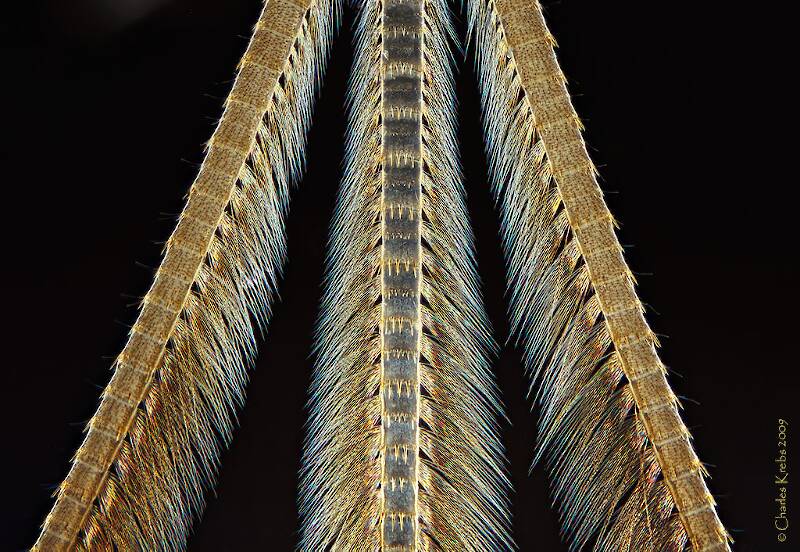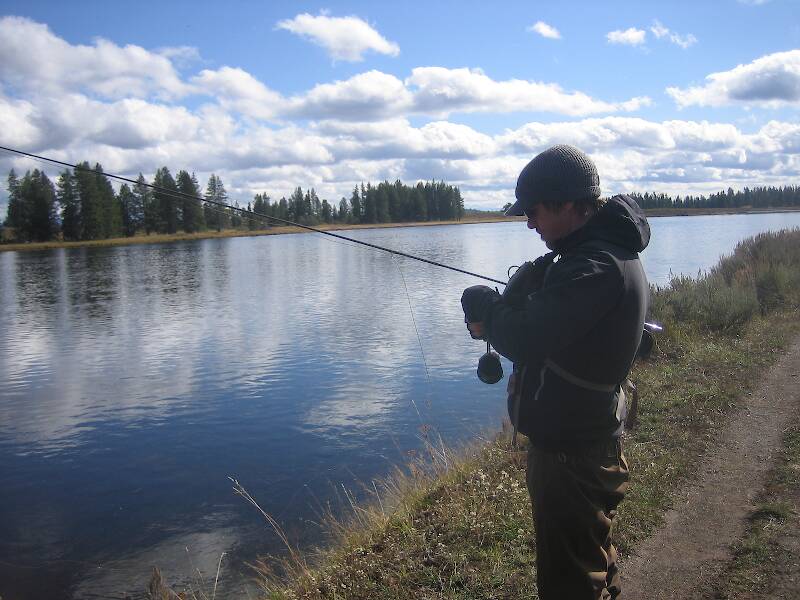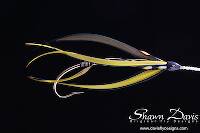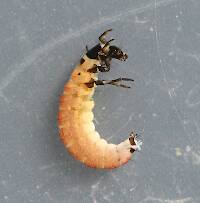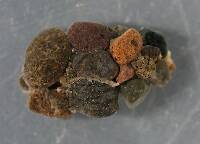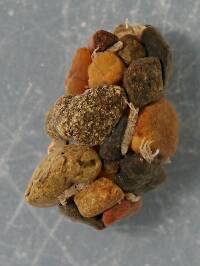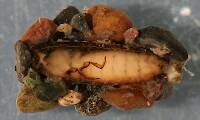
Blue-winged Olives
Baetis
Tiny Baetis mayflies are perhaps the most commonly encountered and imitated by anglers on all American trout streams due to their great abundance, widespread distribution, and trout-friendly emergence habits.
Featured on the forum

This wild-looking little thing completely puzzled me. At first I was thinking beetle or month larva, until I got a look at the pictures on the computer screen. I made a couple of incorrect guesses before entomologist Greg Courtney pointed me in the right direction with Psychodidae. He suggested a possible genus of Thornburghiella, but could not rule out some other members of the tribe Pericomini.

Troutnut is a project started in 2003 by salmonid ecologist Jason "Troutnut" Neuswanger to help anglers and
fly tyers unabashedly embrace the entomological side of the sport. Learn more about Troutnut or
support the project for an enhanced experience here.
Konchu on Jul 22, 2007July 22nd, 2007, 5:34 am EDT
For those of you who don't know, or haven't guessed, I do mayfly research.
http://mypage.iu.edu/~lmjacobu/research.html
I've already formed collaborations with several people who visit this site and wonder who else out there might be interested.
Currently, I'm looking for fresh specimens of about any mayfly species in any identifiable stage.
Is anyone from the USA or Canada up for some field work? If so, send me a Private Message (PM), and we can talk.
Assistance will be duly acknowledged in print, unless anonymity is requested.
http://mypage.iu.edu/~lmjacobu/research.html
I've already formed collaborations with several people who visit this site and wonder who else out there might be interested.
Currently, I'm looking for fresh specimens of about any mayfly species in any identifiable stage.
Is anyone from the USA or Canada up for some field work? If so, send me a Private Message (PM), and we can talk.
Assistance will be duly acknowledged in print, unless anonymity is requested.
Troutnut liked this post.
Troutnut on Jul 22, 2007July 22nd, 2007, 8:37 pm EDT
Luke, I've stickied this topic for you for a while. Let me know if you get enough people and don't need to recruit any more, and I'll un-sticky it.
Can you write a little more here about the specifics of this research? Also, what are you looking for in the way of quantity, specimen preparation, etc? For example, would it be worthwhile for anyone to send you 5 dozen H. limbata spinners they scooped up, or are you just looking for unique bugs?
Can you write a little more here about the specifics of this research? Also, what are you looking for in the way of quantity, specimen preparation, etc? For example, would it be worthwhile for anyone to send you 5 dozen H. limbata spinners they scooped up, or are you just looking for unique bugs?
Jason Neuswanger, Ph.D.
Troutnut and salmonid ecologist
Troutnut and salmonid ecologist
Konchu on Jul 23, 2007July 23rd, 2007, 2:19 am EDT
This project is another big step in sorting out the natural history of North America's mayflies. A colleague and I are working together on a project to make a fresh collection of as many different North American mayflies as possible. Multiple specimens for single species collected from several places will be very helpful so that we can see natural variation.
Specimens should be collected into 100% ethanol, if possible.
We'll pull tissue from the specimens and get information about the DNA. DNA is useful for studying populations and how they move and change and where they came from. It will help answer questions about recolonization of streams and seasonal distributions of species. It is also useful for confirming which spinners go with which nymphs and the like. As some of you have seen in discussions here, current mayfly identification is often more art than science for certain species.
The new scientific tools that we have now can help lead to a better understanding of the basic biology of mayfly species, which in the long run, means an increased ability to manage and conserve freshwater habitats and watersheds.
Specimens should be collected into 100% ethanol, if possible.
We'll pull tissue from the specimens and get information about the DNA. DNA is useful for studying populations and how they move and change and where they came from. It will help answer questions about recolonization of streams and seasonal distributions of species. It is also useful for confirming which spinners go with which nymphs and the like. As some of you have seen in discussions here, current mayfly identification is often more art than science for certain species.
The new scientific tools that we have now can help lead to a better understanding of the basic biology of mayfly species, which in the long run, means an increased ability to manage and conserve freshwater habitats and watersheds.
Konchu on Jul 23, 2007July 23rd, 2007, 3:02 am EDT
I should put a qualification or two on all this.
Right now, I'm just trying to put feelers out to see who is possibly interested in helping. I am not ready for specimens to start pouring in. Even when I am, I will have to be selective about accepting specimens to be practical with my time; this is why I'm communicating with people via PMs.
My thought is that a grassroots effort will enable us to cover a wide geographic area and seasonal span in a short amount of time.
Right now, I'm just trying to put feelers out to see who is possibly interested in helping. I am not ready for specimens to start pouring in. Even when I am, I will have to be selective about accepting specimens to be practical with my time; this is why I'm communicating with people via PMs.
My thought is that a grassroots effort will enable us to cover a wide geographic area and seasonal span in a short amount of time.
Psyfly on Aug 10, 2007August 10th, 2007, 4:51 pm EDT
I really wish I had the time to do something like this. It is wildly interesting
"If I might be judge, God never did make a more calm,quiet, innocent recreation than angling" Isaac Walton
www.tierneysflies.com
www.tierneysflies.com
Shawnny3 on Aug 10, 2007August 10th, 2007, 5:37 pm EDT
You think it's wildly interesting now, wait until Konchu has you jumping off bridges to collect mayfly samples.
-Shawn
-Shawn
Jewelry-Quality Artistic Salmon Flies, by Shawn Davis
www.davisflydesigns.com
www.davisflydesigns.com
Konchu on Aug 10, 2007August 10th, 2007, 11:34 pm EDT
Already a big thanks needs to go out to those who've 'jumped' at the chance to participate.
I'll try to update progress on the project as we go along. Already, I've got about twenty species from the West Coast. People from this site are collecting in several other geographic regions now to get the other 611 some odd North American species. This could mark the first scientific use of the term TroutNut.
Hopefully, a little peer pressure will help me to keep moving on this and sharing the progress. I hope also to share some Web resources that I'm developing as spinoffs of this project that users of this site might find interesting or helpful, including a mayfly habitats page.
If you've got questions or concerns, please let me know.
Here's a link to the program:
http://www.barcodinglife.org/views/login.php
I'll try to update progress on the project as we go along. Already, I've got about twenty species from the West Coast. People from this site are collecting in several other geographic regions now to get the other 611 some odd North American species. This could mark the first scientific use of the term TroutNut.
Hopefully, a little peer pressure will help me to keep moving on this and sharing the progress. I hope also to share some Web resources that I'm developing as spinoffs of this project that users of this site might find interesting or helpful, including a mayfly habitats page.
If you've got questions or concerns, please let me know.
Here's a link to the program:
http://www.barcodinglife.org/views/login.php
Martinlf on Sep 4, 2007September 4th, 2007, 10:36 am EDT
Konchu I've gotten very busy with work and haven't gotten my collecting stuff organized, but I am trying to get around to it.
"He spread them a yard and a half. 'And every one that got away is this big.'"
--Fred Chappell
--Fred Chappell
Konchu on Sep 5, 2007September 5th, 2007, 10:10 am EDT
No worries. I am wrapped up with a number of other projects myself. If anyone else is interested in this, please contact me! At some point, I'll post a list of species that have come from Users of this site.
Konchu on Sep 15, 2007September 15th, 2007, 3:04 am EDT
This yahoo news article give a good introduction to the barcoding project.
http://news.yahoo.com/s/ap/20070915/ap_on_sc/barcoding_life;_ylt=AiOQTr89ZS663V688J1SuYus0NUE
I'm hoping to make a dent in the accumulated specimens in my office this weekend.
http://news.yahoo.com/s/ap/20070915/ap_on_sc/barcoding_life;_ylt=AiOQTr89ZS663V688J1SuYus0NUE
I'm hoping to make a dent in the accumulated specimens in my office this weekend.
Konchu on Nov 2, 2007November 2nd, 2007, 1:36 pm EDT
Hey guys (and gals?). Just a word of thanks to those of you who have been sending me stuff. It's been great! A few of the specimens have my mind reeling.
Before sending any new material, please make sure you get a response from me with new instructions, either from a PM on this website or email (for those of you who have mine).
All the best!
Before sending any new material, please make sure you get a response from me with new instructions, either from a PM on this website or email (for those of you who have mine).
All the best!
Raider83 on Jun 27, 2008June 27th, 2008, 6:16 am EDT
Konchu, if you are still doing this, I would love to help you. I am an amateur entomologist and am especially interested in aquatic insects.
Konchu on Jun 28, 2008June 28th, 2008, 2:25 am EDT
I'm still working on this project. I'll send you a PM, and we can discuss it more.
Bigfly on Dec 14, 2009December 14th, 2009, 2:54 am EST
Konchu, I'm a guide/bugfan. Home water is the Truckee River, CA.
We have a population that to me, seems unique.
Semi-sparse hatches, but a wide variety.
I would enjoy helping out, but especially interested in your ID's.
Can we access info afterwards? Send me a PM if you still need help.
We have a population that to me, seems unique.
Semi-sparse hatches, but a wide variety.
I would enjoy helping out, but especially interested in your ID's.
Can we access info afterwards? Send me a PM if you still need help.
www.Bigflyguideservice.com
BRAT
Posts: 10
Posts: 10
BRAT on Mar 25, 2010March 25th, 2010, 6:54 am EDT
Konchu, this is an old thread, but I'll bite. :-) Any chance you are still doing this project and need some New England samples? I'm in VT and do regular 'Bug Hunts' as a method of introducing people to water quality monitoring.
e-mail is preferred: blackrivercleanup(at)yahoo(dot)com.
Thanks,
Kelly
e-mail is preferred: blackrivercleanup(at)yahoo(dot)com.
Thanks,
Kelly
Konchu on Jul 2, 2011July 2nd, 2011, 4:28 pm EDT
Just thought I'd revive this thread. Getting a little picky now about what we need. Should have a much better idea of where we stand on the project in a few weeks.
Bughunter on Oct 24, 2011October 24th, 2011, 12:09 pm EDT
If you are interested in Arkansas specimen please pm me.
Keegy on Nov 21, 2011November 21st, 2011, 11:13 am EST
I can provide some utah specimens, if needed. Sounds like a cool project.
BRAT
Posts: 10
Posts: 10
BRAT on Dec 5, 2011December 5th, 2011, 1:40 am EST
Hey there...let me know how to go about becoming a field collector, and I'll send you samples of what we find during out educational Bug Hunts here in New England, USA!
Konchu on May 30, 2012May 30th, 2012, 4:26 pm EDT
Here are some now published results from the request I put out a few years ago. This study certainly presents a can of worms. Thank you to all who helped by sending a few specimens. I regret we could not name everyone in text. Happy reading.
http://www.plosone.org/article/info%3Adoi%2F10.1371%2Fjournal.pone.0038063
http://www.plosone.org/article/info%3Adoi%2F10.1371%2Fjournal.pone.0038063
Quick Reply
Related Discussions
Topic
Replies
Last Reply
7
May 9, 2012
by Entoman
by Entoman
1
Apr 12, 2007
by GONZO
by GONZO
0
Oct 14, 2008
by Martinlf
by Martinlf
2
Nov 28, 2012
by Brookyman
by Brookyman
6
Apr 14, 2013
by Troutnut
by Troutnut





